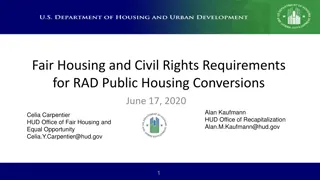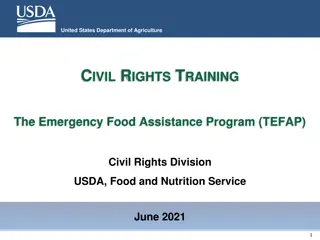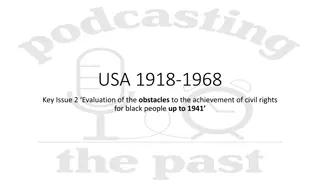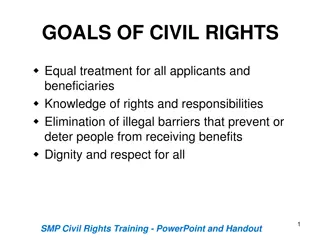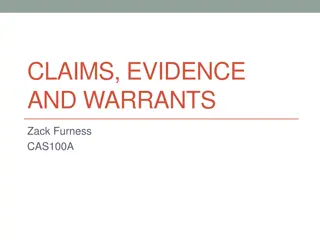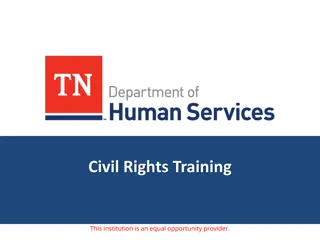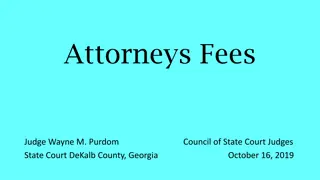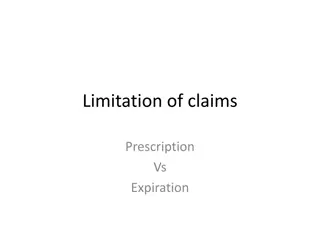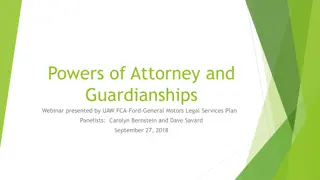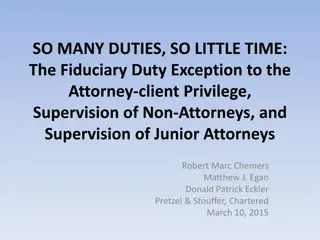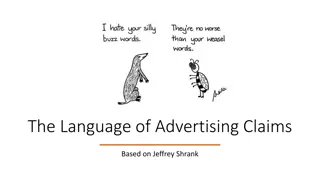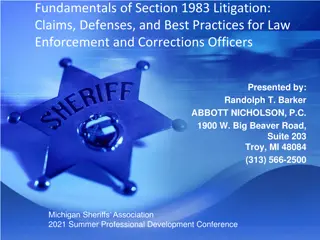Understanding Section 1983 Claims and Civil Rights Attorney Fees
Section 1983 of the Civil Rights Act allows individuals to seek redress for violations of their constitutional rights by persons acting under state law. This provision does not create new rights but provides remedies for existing rights. The history of Section 1983 dates back to 1871 and has been instrumental in addressing abuses and ensuring accountability. To establish a Section 1983 claim, it is crucial to show a violation of constitutional rights by a person acting under state law. The elements of a Section 1983 claim require proof of specific criteria as per Third Circuit Jury Instructions.
Download Presentation

Please find below an Image/Link to download the presentation.
The content on the website is provided AS IS for your information and personal use only. It may not be sold, licensed, or shared on other websites without obtaining consent from the author. Download presentation by click this link. If you encounter any issues during the download, it is possible that the publisher has removed the file from their server.
E N D
Presentation Transcript
PBIs Section 1983 Claims: Civil Rights & Attorney s Fees Under Section 1988 NOVEMBER 2, 2015 12:00 P.M. 4:15 P.M. CLE CONFERENCE CENTER WANAMAKER BUILDING, STE. 1010 PRESENTED BY CLIFFORD A. RIEDERS, ESQ. Rieders, Travis, Humphrey, Waters & Dohrmann 161 West Third Street Williamsport, PA 17701 570-323-8711 www.riederstravis.com
42 U.S.C. Section 1983 Section 1983 of 42 U.S.C. states as follows: Every person who, under color of any statute, ordinance, regulation, custom, or usage, of any State or Territory or the District of Columbia, subjects, or causes to be subjected, any citizen of the United States or other person within the jurisdiction thereof to the deprivation of any rights, privileges, or immunities secured by the Constitution and laws, shall be liable to the party injured in an action at law, Suit in equity, or other proper proceeding for redress 2
Establishing a Section 1983 Claim 42 U.S.C. 1983. Section 1983 of the Civil Rights Act, does not, by its own terms, create any substantive rights. Section 1983 only provides remedies for deprivation of rights established elsewhere in the Constitution for federal laws. Kneipp v. Tedder, 95 F.3d 1199, 1204 (3d Cir. 1996). To establish a claim pursuant to Section 1983, a plaintiff must demonstrate a violation of a right secured by the Constitution and the laws of the United States [and] that alleged deprivation was committed by a person acting under the color of state law. Id. To state a Section 1983 claim, the plaintiff is required to allege that (1) the conduct complained of was committed by a person acting under the color of state law; and (2) the conduct deprived the plaintiff of a constitutional right. 3
History of Section 1983 Section 1983 was enacted on April 20, 1871 as part of the Civil Rights Act of 1871, and is also known as the "Ku Klux Klan Act" because one of its primary purposes was to provide a civil remedy against the abuses that were being committed in the southern states, especially by the Ku Klux Klan. The Act was intended to provide a private remedy for such violations of federal law, and has subsequently been interpreted to create a type of tort liability. The number of cases that have been brought under Section 1983 dramatically increased after the Supreme Court s 1961 decision in Monroe v. Pape.In Monroe, the Supreme Court held that a police officer was acting "under color of state law" even though his actions violated state law. This was the first case in which the Supreme Court allowed liability to attach where a government official acted outside the scope of the authority granted to him by state law. 4
Elements of a 1983 Claim According to the Third Circuit Jury Instructions, a Plaintiff must prove both of the following elements by a preponderance of the evidence: Defendant acted under color of state law. While acting under color of state law, defendant deprived plaintiff of a federal [constitutional right] [statutory right]. 5
Elements of a Section 1983 Claim Every person Only persons are subjected to 1983 liability. A state is not a person, but a state officer can be sued in his personal capacity. 6
Elements of a Section 1983 Claim Who under color of state law The traditional definition of acting under the color of state law requires that the defendant have exercised power "possessed by virtue of state law and made possible only because the wrongdoer is clothed with the authority of state law. West v. Atkins, 487 U.S. 42, 49 (1988). Such actions may result in liability even if the defendant abuses the position given to him by the state. A private actor may also act under color of state law under certain circumstances. Wyatt v. Cole, 504 U.S. 158, 162 (1992); 7
Elements of a Section 1983 Claim: Under Color of State Law A person can act under color of state law even if the act violates state law. The question is whether the person was clothed with the authority of the state, by either using or misusing the authority of the state. State law, means any statute, ordinance, regulation, custom or usage of any state. This includes any political subdivisions of the state, such as a county or municipality, and also any state, county or municipal agencies. Like the state-action requirement of the Fourteenth Amendment, the under-color-of-state-law element of 1983 excludes from its reach merely private conduct, no matter how discriminatory or wrongful. Liability under Section 1983 attaches only to those wrongdoers who carry a badge of authority of a State and represent it in some capacity, whether they act in accordance with their authority or misuse it. National Collegiate Athletic Ass'n v. Tarkanian, 488 U.S. 179, 191 (1988) (quoting Monroe v. Pape, 365 U.S. 167, 172 (1961)). 8
Elements of a Section 1983 Claim: Under Color of State Law The inquiry into the question of action under color of state law is fact-specific. In the usual case courts ask whether the State provided a mantle of authority that enhanced the power of the harm-causing individual actor. Tarkanian, 488 U.S. at 192. The Third Circuit has found such circumstances to include the following: A finding of a sufficiently close nexus between the state and the challenged action of the [private] entity so that the action of the latter may fairly be treated as that of the State itself. A finding that the State create[d] the legal framework governing the conduct. A finding that the government delegate[d] its authority to the private actor. A finding that the government knowingly accept[ed] the benefits derived from unconstitutional behavior. 9
Elements of a Section 1983 Claim: Under Color of State Law A finding that the private party has acted with the help of or in concert with state officials. A finding that the action result[ed] from the State's exercise of coercive power. A finding that the State provide[d] significant encouragement, either overt or covert. A finding that a nominally private entity . . . is controlled by an agency of the State. A finding that a nominally private entity . . . has been delegated a public function by the State. A finding that a nominally private entity . . . Is entwined with governmental policies, or [that] government is entwined in [its] management or control. 10
Elements of a 1983 Claim: Depriving Plaintiff of a Federal Right By its terms, Section 1983 can be used to remedy the deprivation of rights granted to the plaintiff under the Constitution, federal statutes, and regulations implementing these statutes. In Cort v. Ash, 422 U.S. 66 (1975) the Supreme Court enunciated a four-part test to determine whether Congress intended to imply a right to sue directly under a federal statute. A plaintiff asserting the right is required to show that (1) membership in the class for whose benefit the statute was enacted, (2) evidence of Congress intent to confer a private remedy, (3) that a right to sue would be consistent with the statutory purpose, and (4) that the cause of action is not one traditionally relegated to the states to a degree that implying a right to sue would be inappropriate. The plaintiff must show that Congress intended to grant both a private right and a private remedy. In the years following Cort, the judiciary became less willing to find rights of action implied directly under a statute, and plaintiffs began turning to Section 1983 the alternative path for enforcing rights created by federal statute. 11
Elements of a 1983 Claim: Depriving Plaintiff of a Federal Right In Maine v. Thiboutot, the Supreme Court held for the first time that Section 1983 could be used to remedy the deprivation of rights created by a federal statute. In Wright v. Roanoke Redevelopment and Housing Authority, the Supreme Court suggested that a regulation promulgated to interpret a federal statute could also be a law which could be enforced under Section 1983. The initial three-pronged test for finding a right enforceable under Section 1983 was set forth in Wilder v. Virginia Hospital Association, 496 U.S. 498 (1990). It asks whether (1) Congress intended the particular statutory provision to benefit the putative plaintiff, (2) the provision is not so vague or amorphous as to make judicial enforcement difficult or impractical, and (3) the statute imposes a binding obligation on the government. Id.; see also Blessing v. Firestone, 520 U.S. 329 (1997). After these inquiries, a fourth arises: (4) did Congress create a comprehensive mechanism for enforcing the statute which implies that it intended to deny a private right of action under Section 1983. 12
Elements of a Section 1983 Claim [ . . .Subjects or causes to be subjected ] Section 1983 does not impose a state of mind requirement independent of the underlying basis for liability, but there must be a causal connection between the defendant's actions and the harm that results. Mt. Healthy City School Dist. Bd. of Educ. v. Doyle, 429 U.S. 274, 285-87 (1977). The U.S. Supreme Court has interpreted this causation element to require that the harm be the result of action on the part of the government entity that implemented or executed a policy statement, ordinance, regulation, or decision officially adopted and promulgated by that body's officers, or the result of the entity's custom. Monell v. Department of Social Services of the City of New York, 436 U.S. 658, 690-691 (1978). The Supreme Court has rejected the notion that a plaintiff must meet a heightened pleading standard to state a claim against a municipality for an unconstitutional custom or policy. Leatherman v. Tarrant County, 507 U.S. 163 (1993). There is, however, a heightened pleading standard for individual capacity claims. 13
Elements of a Section 1983 Claim [any person to] the deprivation of rights . . . Section 1983 is not itself a source of substantive rights, it merely provides a method for the vindication of rights elsewhere conferred in the United States Constitution and Laws. Therefore, a plaintiff may prevail only if he can demonstrate that he was deprived of rights secured by the United States Constitution or federal statutes. Chapman v. Houston Welfare Rights Org., 441 U.S. 600, 617 (1979). The 14thAmendment s Due Process Clause is the most commonly invoked substantive right. To state a claim for a deprivation of Due Process, a plaintiff must show: (1) that he possessed a constitutionally protected property interest; and (2) that he was deprived of that interest without due process of law. 14
Elements of a Section 1983 Claim shall be liable . . . in an action at law, Suit in equity, or other proper proceeding for redress . . . There is no requirement that the plaintiff sue in federal court because state courts have concurrent jurisdiction. Usually, exhaustion of administrative and judicial state remedies is not a prerequisite to a section 1983 action. 15
Absolute and Qualified Immunity Defense States and state agencies are entitled to Eleventh Amendment immunity in federal court. Edelman v. Jordan, 415 U.S. 651 (1974). State and regional legislators are absolutely immune, as long as they are engaged in traditional legislative functions. Local legislators, such as city council members and county commissioners, have been guaranteed absolute immunity since Bogan v. Scott-Harris, 523 U.S. 44, 118 S. Ct. 966 (1998). Individual capacity defendants are protected by qualified immunity. Government officials are entitled to qualified immunity unless their "act is so obviously wrong, in the light of preexisting law, that only a plainly incompetent officer or one who was knowingly violating the law would have done such a thing. 16
Absolute and Qualified Immunity Defense An individual defendant in federal courtmay immediately appeal a denial of qualified immunity, even if a prior appeal of the denial of qualified immunity was unsuccessful, and even if other claims remain for trial. Private individuals who perform state functions, and private corporations who contract with the government may not be entitled to qualified immunity. 17
Absolute and Qualified Immunity Defense The Supreme Court has also recognized a qualified immunity defense to section 1983 actions in certain circumstances. Most state and local officials and employees, who do not enjoy absolute immunity, are entitled to qualified immunity. Thus, a prosecuting attorney who enjoys absolute immunity in performing her prosecutorial functions may also enjoy a qualified immunity in hiring and firing subordinates. The Supreme Court has held that school board members, state mental institution administrators, law enforcement officers, prison officials, and state and local executives have qualified immunity. While prison guards employed by the government (local, state, or federal) are covered under qualified immunity, guards who work in for-profit prison management companies are not. 18
Burden of Proof The Plaintiff bears the burden of proof on all elements of a Section 1983 claim. Groman v. Township of Manalapan, 47 F.3d 628, 638 (3d Cir. 1995). Although the defendant has the burden of pleading the defense of qualified immunity, Gomez v. Toledo, 446 U.S. 635, 640 (1980), the Supreme Court has not definitively established who bears the burden of proof with respect to that defense. The Third Circuit has stated that the defendant bears the burden of proof on qualified immunity. See, e.g., Burns v. PA Dep t of Corrections, 642 F.3d 163, 176 (3d Cir. 2011). 19
Remedies The Supreme Court has held that section 1983 creates "a species of tort liability" Imbler v. Pachtman,424 U.S. 409 (1976). A section 1983 plaintiff is also required to prove that a federal right was violated and, similar to tort law, that the alleged violation was a proximate or legal cause of the damages that the plaintiff suffered. Arnold v. IBM Corp., 637 F.2d 1350 (9th Cir. 1981). Punitive damages are available under section 1983. Smith v. Wade,461 U.S. 30, 103 S. Ct. 1625 (1983). A plaintiff is entitled to punitive damages if the jury finds that the defendant's conduct was reckless or callously indifferent to the federally protected rights of others or if the defendant was motivated by an evil intent. The jury has the duty to assess the amount of punitive damages. Because the purpose of punitive damages is to punish the wrongdoer, such damages may be awarded even if the plaintiff cannot show actual damages. 20
Section 1983 Liability for Failure to Train or Supervise Section 1983 provides a remedy for violation federally protected rights by government and its employees. Civil litigants were still precluded from suing governmental entities themselves until 1978 when the Supreme Court decided Monell v. New York Department of Social Services, 436 U.S. 658 (1978). 21
Monell v. New York Department of Social Services In Monell, the Supreme Court held that governments could be persons under the language of Section 1983, but that such liability could not be based on respondent superior basis. 22
City of Canton v. Harris One of Harris s theories of liability was that the City of Canton had failed to adequately train its officers about providing medical assistance beyond emergency first aid treatment. The Circuit Court had held that government could be liable for a failure to train when it acted recklessly, intentionally or with gross negligence. The Supreme Court granted cert. to consider the applicable standard for providing liability based on a failure to train theory. 23
City of Canton v. Harris The Supreme Court first cited its reasoning from Monell that it is only when the execution of the government s policy or custom . . . inflicts the injury that the municipality can be held liable under 1983. The Supreme Court acknowledged that there are limited circumstances where an allegation of failure to train can be the basis of 1983 liability. The Supreme Court held that the inadequacy of police training may serve as a basis for 1983 liability only when the failure to train can amount to deliberate indifference to the rights of persons with whom the police come in contact. 24
City of Canton v. Harris The Court held that a municipality may be held liable under Section 1983 for violation of rights guaranteed by the federal constitution, which violations result from the municipality s failure to adequately train its employees, only if that failure results in a deliberate indifference on the part of the municipality to the constitutional rights of its inhabitants. The Court was concerned that allowing a lesser culpability standard than deliberate indifference would result in de facto vicarious liability, and was further concerned that the federal courts should not be in the business of second guessing employee training programs. Harris makes clear that the viability of a failure to train claim must contain sufficient evidence of the following facts: 1) a violation of a federally protected right 2) inadequate training of employees 25
Two Types of 1983 Training Liability Courts have recognized that Section 1983 training liability can arise in two potential scenarios: 1) where a series of constitutional violations makes the need for training obvious. Such a pattern of constitutional violations is typically necessary to demonstrate that a governmental entity was deliberately indifferent to its citizens constitutional rights. 2) 1983 liability can also arise in the absence of a pattern of violations where the need for training on a particular issue was obvious at the onset. 26
Connick v. Thompson The Supreme Court recently tightened liability standards for Section 1983 claims involving an alleged failure to train governmental employees. In Connick, the Supreme Court reversed a 14 million award to a plaintiff-former prisoner. The Supreme Court rejected the former prisoner s claim in Connick because it did not within the narrow range of . . . hypothesized single incident liability concerning where the need for training was obvious at the onset. The court noted that armed police must make split second decisions with life or death consequences, where as prosecutors have legal training and take continuing legal education. The Court held that: 1) prior, unrelated Brady violations by attorneys in his office was insufficient to put district attorney on notice of need for further training, and 2) need for training was not so obvious that district attorney's office was liable on failure-to-train theory when nondisclosure of blood-test evidence had resulted in defendant's wrongful conviction and in his spending 18 years in prison. 27



